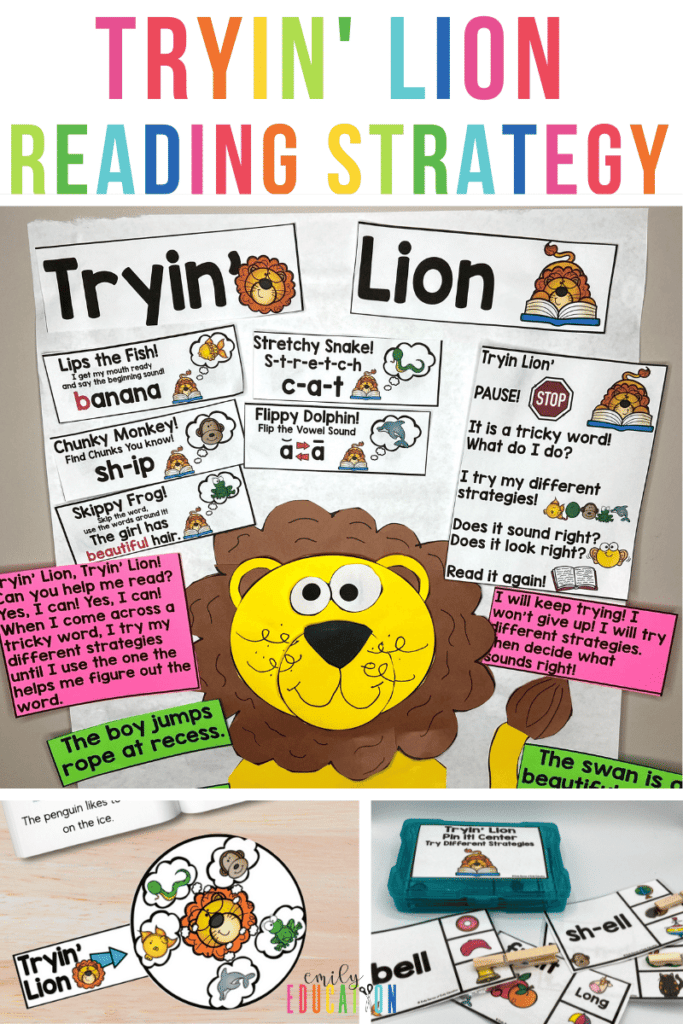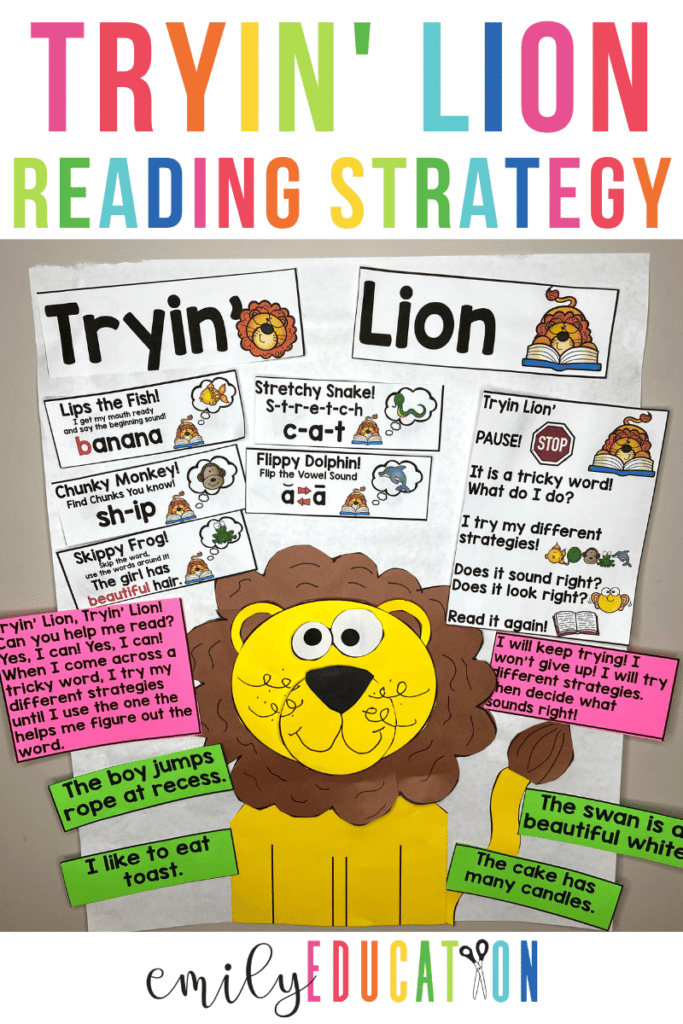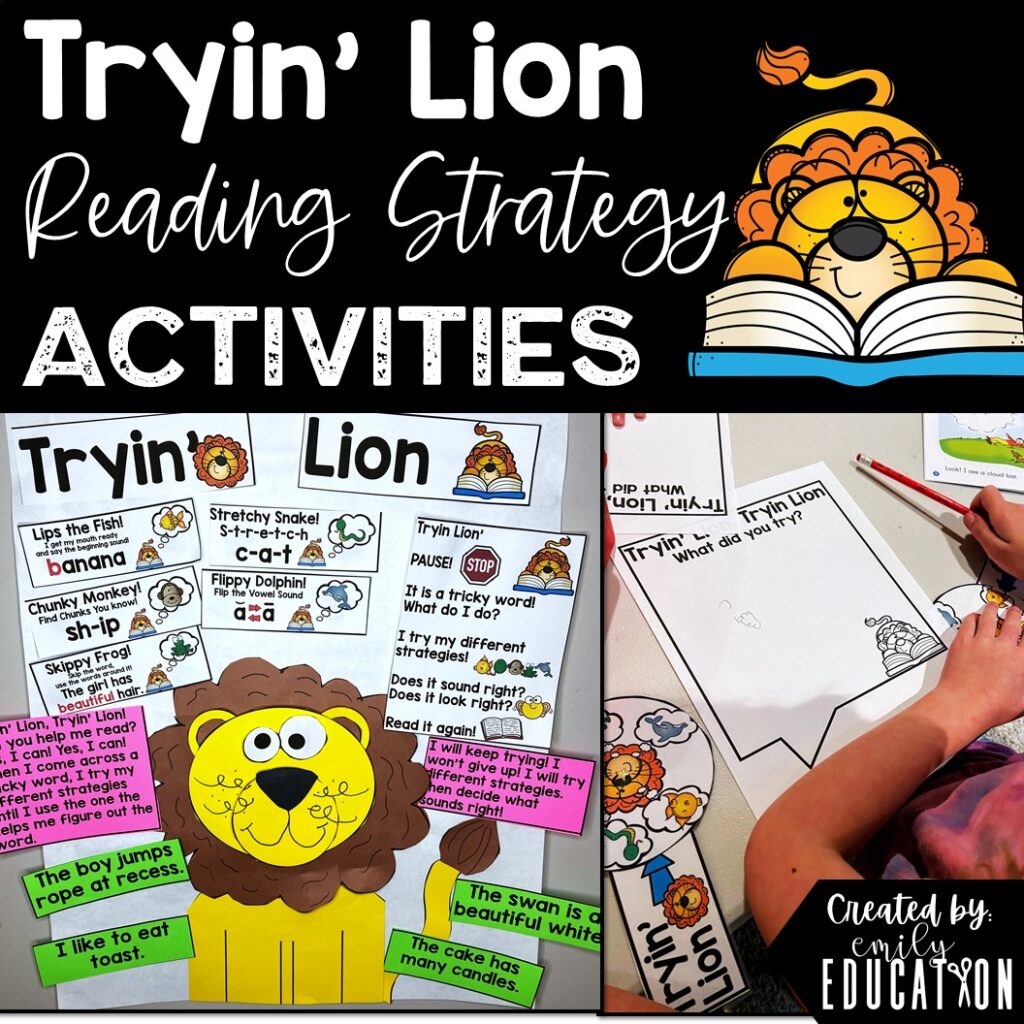Every good teacher knows how important it is to have strategies in place to help their young learners as they are beginning to read. With reading strategies like Lips the Fish, Stretchy Snake, Chunky Monkey, Flippy Dolphin, and Skippy Frog, your students will have all the tools they need to help them become fluent readers. The Tryin Lion reading strategy brings them all together. Here are my favorite activities to help your students remember these strategies while they are continuing on their reading journey.

What is the Tryin’ Lion Reading Strategy
The Tryin’ Lion reading strategy is the last reading strategy in the character series. The Tryin’ Lion reminds students not to give up when they come to a word they don’t know. Instead, he reminds students to try all the reading strategies they have learned. This little reminder is a great way to pull all of the other reading strategies together and help students decode unfamiliar words.
The reading strategies Tryin’ Lion focuses on include:
I choose not to include the Eagle Eye strategy in the Tryin’ Lion activity. I really want my students using phonics to help them figure out the challenging word with the other reading strategies they have learned.
Tryin’ Lion Introduction

While the Tryin’ Lion reading strategy isn’t introducing a new reading strategy, it the perfect way to review the other important strategies.
I like to take my students on a virtual safari to help them remember the strategies they have learned. Because each strategy is represented by a cute animal, this is a super fun activity. I use the stuffed animals or images from our previous reading strategies and hide them throughout the room for my students to find. You can even go on a safari through the school with a little advanced planning.
Once an animal is found, we bring it to the board and talk about the reading strategy the animal represents. This strategic review will help us build our Tryin’ Lion anchor chart during our next activity.
Tryin’ Lion Anchor Chart
Now that your students have found all of the animals that represent the different reading strategies, it’s time to review how each strategy helps us read.
Just like the other reading strategy anchor charts, this is going to be a collaborative project. Students work together to put our Tryin’ Lion front and center on the anchor chart.
The cute Tryin’ Lion rhyme reminds us to keep trying and use our animal friends when we need them. The goal of the Tryin’ Lion strategy is to give students the confidence to try to figure out new words using some of the strategies they already know.
I make sure to take time to review each of the reading strategies one at a time. We talk about how they help us when we come to a tricky word. One at a time, we attach the animals to the anchor chart with a reminder of how to use it and an example sentence or word.
If you prefer to do this step with small groups, you can assign one reading strategy to each group. Ask them to come up and put their cards on the anchor chart and remind them class how it’s used. I know my students always love when they get to be “kid experts”.
Tryin’ Lion Reading Tool Activity
Now it’s time to make our Tryin’ Lion reading tool!

This moveable and interactive tool is a great visual reminder. It helps students remember the different reading strategies they have learned so far.
I make sure to keep our anchor chart up where students can see it throughout the week just in case they need a quick little reminder about how to use Lips the Fish, Stretchy Snake, Chunky Monkey, Flippy Dolphin, or Skippy Frog.
I copy the templates on thick cardstock, cut, and then laminate the pieces. My students love putting in the brads to make the pieces moveable. This means they can move the rectangle to point to the reading strategy they are going to use.
To use the Tryin’ Lion reading tool, just grab some leveled readers and let students start reading out loud. When they come to a word they don’t know, they will turn the Tryin’ Lion arrow to one of the animal friends. Then they can try out that reading strategy.
The best part is, they are able to move the arrow and try different strategies until they find the one that works.
Tryin’ Lion Practice Pages
As your students are becoming more comfortable with using the different strategies, it’s important to keep giving them lots of practice opportunities.
Worksheets are a great way for students to get in some practice throughout the week as they are learning how to decide which reading strategies to use.
I love the Tryin’ Lion worksheets because they give students the opportunity to try out the different reading strategies they have learned.
One set of worksheets includes words, sentences, or missing letters with two answers for students to choose from. To give them a little extra help, an image of the animal representing the reading strategy to help them find the answer can be found in the corner or each square.
The other worksheet gives students some extra fine motor skill practice by including images representing the word at the bottom of the page for students to cut and paste into the correct row for each unknown word. Just like the other worksheet, our helpful animal friends appear in the corner to remind students which reading strategy to try.
Tryin’ Lion Center Activities
I absolutely love adding reading strategy practice into our center activities. These Tryin’ Lion center cards are a fun activity to help students get even more practice using all of their reading strategies.
Pin it Cards
Students will use the fun laminated Tryin’ Lion reading tool and cards to identify the new words This pin-it card reading center is so much fun and a great way to have students practice independently.
Each card includes a words, images, an animal strategy clue to help students know which of the strategies to use. Students use clothespins to indicate the correct punctuation for the sentence on each card.
Match it Cards
I also like to include the Tryin’ Lion matching cards as a center activity. Students determine what reading strategy to use to figure out a new word and match the correct picture to the word.
It’s a great opportunity to practice all of the different reading strategies they have learned. It is also a great reading fluency activity as I like to have students read the words multiple times.
Both of these center activities are easy to prep and store. I like to keep all the cards and supplies together using a small pencil box or zip-lock bag. With everything stored in one place, students can quickly and easily grab the activity and begin working.
Tryin’ Lion Student Craft
My students always look forward to the student craft at the end of the week, and the Tryin’ Lion craft is no exception. But this wrap-up craft is more than just an arts and crafts time. Students will actually be putting the Tryin’ Lion strategy into practice.
Students will grab a book and their Tryin’ Lion reading tool. They will read their book looking for unfamiliar words. When they come to a tricky word, they use their Tryin’ Lion tool to help them determine the correct reading strategy to use when reading aloud.
Next, students create a cute Tryin’ Lion page to add their new words to. The finished craft makes a great classroom or hallway display.
It’s also a great way to quickly assess your student’s understanding of each of the reading strategies they have learned. My students always love taking these home to show off to their families at the end of the week too!
Grab The Tryin’ Lion Anchor Chart And Activities Set
You can grab the Tryin’ Lion Anchor Chart and Activities Set in the Emily Education store today! With these carefully crafted activities, your students will be using and reviewing all of these helpful reading strategies in no time!
Readin Strategies For The Win
The Tryin’ Lion reading strategy includes so many helpful reading strategies that scaffold learning for your students. Be sure to check out all of these amazing reading strategies sure to get your students excited about learning to read.
Save These Tryin’ Lion Reading Strategy Activity Ideas
Pin this to your favorite classroom Pinterest board so you can quickly come back when you are looking for fun and engaging activities for teaching your students to read.





